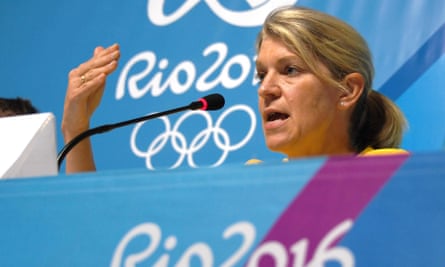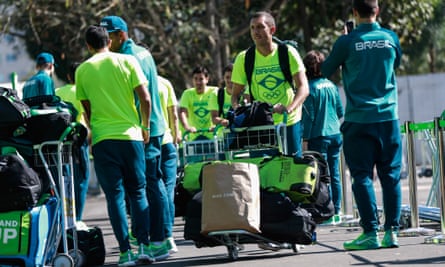Less than two weeks ahead of the Olympics, the Rio 2016 organising committee has acknowledged that 19 of the 31 buildings in the Athletes Village have yet to pass safety tests.
With hundreds of athletes turning up by the day, this will add to concerns prompted by gas and water leaks and at least one power outage. The Guardian has also learned that a short circuit caused a small fire on Saturday.
Close to 10% of the competitors have already arrived in Brazil and many are housed in the village, though the shoddy conditions – which include flooded floors, broken elevators, mould and holes in the ceiling – have shocked some team managers, athletes and volunteers.
The organisers promise to resolve the problems by Thursday, but in the interim the Australian team has decided to temporarily rehouse its athletes. The Dutch and Italian teams have also complained and hinted that there may be demands for compensation.
Stress tests – which should have been done months ago – are still less than halfway complete because the 17-storey buildings were delivered behind schedule and the water, gas and electricity were only recently connected.
Although Rio2016 said the faults affected only 5% of the rooms, spokesman Mário Andrada admitted only 12 of the 31 tower blocks have been checked and proved OK.
“This should have been tested a long time ago,” he told the Guardian. “But the problem is there and now our task is to fix it as quickly as possible and to ensure everything is safe.”
The risks were evident on Saturday when a small fire broke out in building 26, which is the home of the Dutch team.
“A technician was working on a fuse box. There was a short circuit and a small fire, which he extinguished himself. The electricity was disconnected and there was no need for an evacuation or to call firefighters,” Andrada said.
Nonetheless, with continued reports of gas leaks in the Athletes Village, such incidents are a concern.
The Dutch team said it was notified about the fire and it has subsequently conducted tests of fire alarms and emergency stairwells, but its technicians are still encountering new problems, particularly with the plumbing.
Maurits Hendriks, the Dutch chef de mission, said it will be a major challenge to get the accommodation fully ready before the Games begin even though its technical staff and local contractors are working 24 hours a day. “Of course, this is a disappointment. It affects all participating countries,” he said in a statement.
He hinted that there may be financial consequences. “It is the responsibility of the organizing committee to deliver a safe and well-functioning village … Let it be clear that we will evaluate this situation with IOC and Rio 2016 after the Games. This applies for example to financial consequences as a result of the measures we are taking and have been taken.”

He said some teams have had to move buildings. There is a priority list of reconstruction work needed for others. The Netherlands, Australia, New Zealand, Belgium and the UK are in daily contact about the situation.
The Australian team, which was due to be housed in building 23, is refusing to use the Athletes Village until leaks and other problems are resolved and the checks are done to its satisfaction.
Recently, it was the first team to conduct a full stress test of the plumbing system, which involved flushing all the toilets and running all the taps at the same time. The result was water running down the walls.
“Clearly, it’s not safe,” said the team spokesman, Michael Tancred. “But we are hopeful the problems will be resolved and we’ll be in the village by Tuesday or Wednesday.” The first six Australian athletes, who arrived on Monday morning, are temporarily being rehoused in the media village.
But relocation of the Olympic teams may not be an option. One of the reasons why the athletes’ and media villages are so large is that Rio does not have much spare hotel capacity.
The British team, which is staying in one of the 12 finished buildings, said it has faced relatively few inconveniences. Team GB said there had been minor plumbing and electricity issues, but nothing that created a sense of vulnerability.
“We’re in a much better place than other people,” spokesman Scott Field said.
Meanwhile, Patrick Sandusky, the chief external affairs officer for the US Olympic Committee, said the situation was being monitored. “As is the case with every Games, we’re working with the local organizers to address minor issues and make sure the Village is ready for Team USA athletes,” he said.
The Italian team has experienced problems that have obliged it to contract out renovations, the head of mission, Carlo Mornati, told Gazzetta dello Sport. However, Rio 2016 said 630 workers have been deployed to make sure all the glitches are cleared up and checked for safety. “We hope to be finished by the end of business tomorrow night,” Andrada said.
With so much work remaining that will be an immense challenge.
By the opening ceremony on 5 August, the majority of the expected 10,000 athletes are due to be housed in the Athletes Village, which the official website says is the biggest ever at an Olympics. The facilities will include the latest creature comforts, it says: “Athletes staying in the village will be treated like kings. They are, after all, the stars of the show.” But the plans have been knocked awry by a financial downturn and a corruption scandal.

The near-billion-dollar project – also known as Ilha Pura – was built by local property developer Carvalho Hosken and Brazil’s biggest construction firm, Odebrecht. They planned to recoup their investment by selling the apartments for up to 1.5m reais each, but the property market has plunged by 20% over the past year. Earlier this year, Ilha Pura admitted they pre-sold just 240 of the 3,604 apartments – well below forecasts.
This is likely to have caused cashflow problems and headcount cuts during the final stages of the work. Odebrecht, meanwhile, was distracted and leaderless as a result of the jailing of its president, Marcelo Odebrecht, in the Lava Jato (“car wash”) corruption investigation. He was sentenced to 19 years in prison earlier this year.
The organisers and the Rio city government, however, repeatedly insisted neither the financial downturn nor the scandal would disrupt the delivery of facilities for the Games.

Comments (…)
Sign in or create your Guardian account to join the discussion